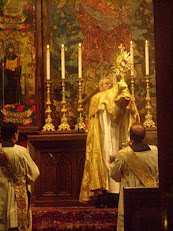The monthly Update from the Sodality of St. Edmund, King and Martyr in Cambridge, Ontario has been released, and has a wonderful article by Msgr. Robert Mercer, CR. The full Update may be read here.
Close to Brussels in Belgium is an ancient city which Walloons or Francophone Belgians call Malines, and which Dutch speaking Belgians or Flemings call Mechelin. Its archbishop is always Primate of Belgium. He therefore wears the pallium, about which I wrote last month, and is usually a cardinal. Archbishop Desire-Joseph Mercier made a name for himself during Germany's occupation of his country in the First World War.In last month's column I observed how little some Anglicans know about Anglicanism. How many know that this Belgian city was once the scene of serious talks about rapprochement between Canterbury and Rome? I myself am frequently reminded of this fact. The slow train to Amsterdam stops in Mechelin/Malines. From its window I gaze at all the medieval churches and wonder which of them might be the cathedral. On one of its walls is a tablet commemorating the Malines Conversation. Some time between the mid 1970's and mid 1980's the Superior of the Community of the Resurrection, Father Eric Simmons, was invited to the unveiling of this plaque. Two Archbishops of Malines, Cardinals Suenens and Daneel, have visited Mirfield. The latter celebrated mass at our high altar, with all the brethren in choir, though of course not communicating. In our Church of the Resurrection are the tombs of our first two Superiors, Bishops Charles Gore and Walter Frere, who participated in those Conversations. So every time I enter our church, walking past the tombs, I am reminded of Mechelin/Malines and the quest for rapprochement. Father Frere's personal attraction was Eastern Orthodoxy. He visited Russia four times before the Bolshevik revolution of 1917. During the First World War he was acting principal of a Serbian Orthodox seminary in England. One of his last public acts was to sing the Anglican litany in the Russian cathedral in Paris. After his death a Russian nun stayed at Mirfield to paint a large icon to hang over his tomb. She fasted and made a retreat before painting our Lord's face. But it was Walter Frere who got the ball rolling for Malines.Anglican bishops at the Lambeth Conference of 1920 issued An Appeal to All Christian People. In it they said that in the interests of reunion they would be willing to accept a form of commissioning from other churches in order that the ministry of Anglican clergy might be recognized by others. Frere noticed this and drew it to the attention of a Roman Catholic friend in France, Fr Fernand Portal. He in turn wrote to Cardinal Mercier. Viscount Halifax, a devout layman in Yorkshire, an enthusiastic ecumenist with a chapel in his manor house where he attended mass every day dark and early, got on with the practical arrangements.Five Conversations took place between 1921 and 1926. Anglican participants were Gore, Frere, Lord Halifax, Dr Armitage Robertson, Dean of Wells cathedral, and Dr Beresford Kidd, Warden of Keble College, Oxford. Catholic participants were Fr Van Roey, vicar general of Malines, and three priests from France, Frs Portal, Pierre Batiffol, and Hemmer. In 1930 Halifax published The Conversations at Malines while Frere published Recollections of Malines in 1935. In 1996 Fr Bernard Barlow, a Catholic priest, wrote A Brother Knocking at the Door: The Malines Conversations 1921 - 1926. In 2011 there appeared a collection of essays called Walter Frere: Scholar, Monk, Bishop which covered many aspects of his multi faceted life, historian, liturgist, musician, one of the founders of CR, though curiously enough there is no chapter about his love of Orthodoxy. To this collection of essays Fr Barlow contributed a chapter on Malines.One of Archbishop Mercier's friends and theological advisers was the Benedictine monk, ecumenist and liturgist, Fr Lambert Beaudin. So great was his love for Orthodoxy that he was founding Abbot of Chevetogne, a monastery in Belgium devoted to the rapprochement of Eastern and Western Christianity. Some of the monks observe the Rule of St Benedict and worship according to the rite of the Latin church, while other monks observe the Rule of St Basil and worship according to the liturgy of St John Chrysostom. But Abbot Beaudin was also benign towards Anglicanism. He wrote, "An Anglican church absorbed by Rome and an Anglican church separated from Rome are equally inadmissible". This later morphed into the mantra beloved of Anglicans, "United but not absorbed". Cardinal Mercier died of cancer in 1926, leaving his ring to Lord Halifax; it finally ended up in one of the chalices of York Minster. A signed photograph of Mercier hung in the Cloister at Mirfield.The Conversations got nowhere at the time. Both churches took fright, "Lord give us unity but not yet", to misquote St Augustine of Hippo. But in October 2010 the Congregation for the Doctrine of the Faith issued a statement preparatory to the publication of Anglicanorum coetibus. The statement said: "Throughout the more than 450 years of its history the question of the reunification of Anglicans and Catholics has never been far from mind. In the early 20th century Cardinal Mercier of Belgium entered into well publicized conversations with Anglicans to explore the possibility of union with the Catholic Church under the banner of an Anglicanism "reunited but not absorbed". Since the Vatican Council, Anglican- Catholic relations have created a much improved climate of mutual understanding and co operation. With Anglicanorum coetibus the Catholic Church is responding to the many requests from groups of Anglican clergy and faithful in different parts of the world who wish to enter into full visible communion. Anglicanorum coetibus has provided a structure that provides for such corporate reunion by establishing Personal Ordinariates."Deo Gratias!Msgr. Robert Mercer CR














No comments:
Post a Comment